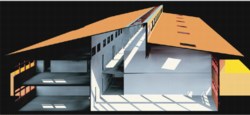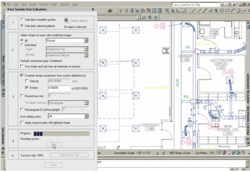Proactive About Part L?
Designing integrated buildings requires integrated design packages. David Payne explains how CADline has been working on a fully-integrated design and analysis solution for smarter compliance with Part L. Over one year on from Part L coming into force, there is still enough confusion around to get many building-services engineers feeling slightly hot under the collar. Some are still finding their current software they are using contrary — for example, in favouring air-conditioned rather than naturally ventilated buildings. Next, the continuing need to show energy efficiency in operation will begin to bite — bringing more work and more worry for both owners and contractors.
Simulation modelling Now, it seems, the CIBSE has proposed a scheme to allow building-control officers to accept thermal simulation modelling using proprietary dynamic software, rather than just SBEM. Can this help the situation? Amid the fog surrounding the whole issue, one point is becoming increasingly clearer — analysis and modelling are far more valuable and productive than just measuring and testing. It appears that to remain both compliant and competitive, building-services firms are looking for fully-integrated, bi-directional analysis tools that enable engineers to virtually experience a building’s performance before it is actually constructed. Over the past few years, CADline has been working intensively on bringing together three software products (Cymap, Tas Building Designer and AutoCAD MEP) to achieve this. AutoCAD MEP (formerly Autodesk Building Solutions) is the AutoCAD-based software developed specifically for building services engineers; it automates production of construction documents using enhanced single-line and double-line system design and layout productivity tools. The beauty of using this software is that it enables engineers to collaborate seamlessly with architects also using AutoCAD-based solutions. It also eliminates a significant amount of routine drafting and co-ordination, helping increase accuracy and productivity in general.
 |
Simulating the performance of a building enables options to be evaluated at an early stage to consider improvements to the building envelope and the building services. |
With the option of mechanical or electrical modules, Cymap offers comprehensive solutions for heating, cooling and energy consumption, piped and ducted services and low-voltage wiring and lighting design. It can be used at all stages of the design process, from initial conception through scheme design to the production of working and record drawings. Finally, Tas is a suite of software products which simulate the dynamic thermal performance of buildings and their systems — enabling users to compare alternative heating/cooling strategies, energy demand and check designs for Part L compliance. The main module, Tas Building Designer, performs dynamic building simulation with integrated natural and forced airflow. As stand-alone solutions, each piece of software delivers powerful productivity benefits. Yet, by looking at the bigger picture and bringing them together, CADline aims to make compliance easier, faster and smarter by enabling clever, rather than just highly specified and expensive, answers to the challenge. The underlying objective is to provide fully-integrated, 2-way dataflow throughout the design process — so removing the need to input data more than once.
In practice One of our early customers is Integrated Design Associates (IDA), a specialist, multi-disciplinary building-service-engineering company. IDA has been using both the electrical and mechanical versions of Cymap and has recently cross-graded from AutoCAD to AutoCAD MEP. The next step will be the integration of Tas Building Designer, and David Reading, IDA partner, believes that these three solutions together will cut design time by two-thirds. The need for repetitive manual data entry was preventing IDA from working as productively as it wanted to. ‘There’s no doubt that the need for compliance has meant more work, and this has created the dilemma of whether to employ extra staff,’ says David Reading. ‘However, the industry is still short of skilled engineers and, consequently, finding the right people is not just difficult, it’s expensive too. Besides, we wanted our engineers to do what they are trained to do — design, not spend time doing data entry and calculations.’ The answer came when he attended a CADline industry seminars on compliance. ‘Comparing the CADline integrated solution with the Government’s own iSBEM, I realised that the CADline solution would result in a far higher quality end result for our clients.’ He underlines the way the solution offers far more than just a test and measurement and exercise. ‘It allows us to produce compliancy statements so that we can clearly understand how the building and its associated systems are going to perform. This enables us to evaluate options at an early stage in order to consider improvements to both the performance of the building “envelope” and the building-services systems required to satisfy user requirements. ‘As a result, overall energy wastage and client’s predicted energy costs are minimised.’
Proactive The Government may bring in increasingly stringent legislation on energy-efficiency — but perhaps only when it all makes commercial as well as environmental sense, will the mainstream industry approach the issue with a mix of urgency and panache. Firms such as IDA see that being proactive about reducing carbon emissions rather than doing the minimum to scrape through compliance adds long-term value.
 |
IIntegrated software packages such as CADline eliminate a significant amount of routine drafting and co-ordination. |
However, this is only economically viable using a seamless combination of dynamic models and analysis tools. Anyone can recommend upgrading the services, but you need a way of intelligently interrogating the options available and balance efficiency with cost. ‘We couldn’t do our job now without using the solution,’ says David Reading. ‘There’s no way we could go back to our former methods as we would not be able to remain competitive.’ While the industry may have been slow to see Part L as an opportunity rather than a challenge, it is catching up fast. By considering a fully-integrated system, firms could reap the rewards.
For more information on this story, click here:
June 07, 70Related links:
Related articles:











